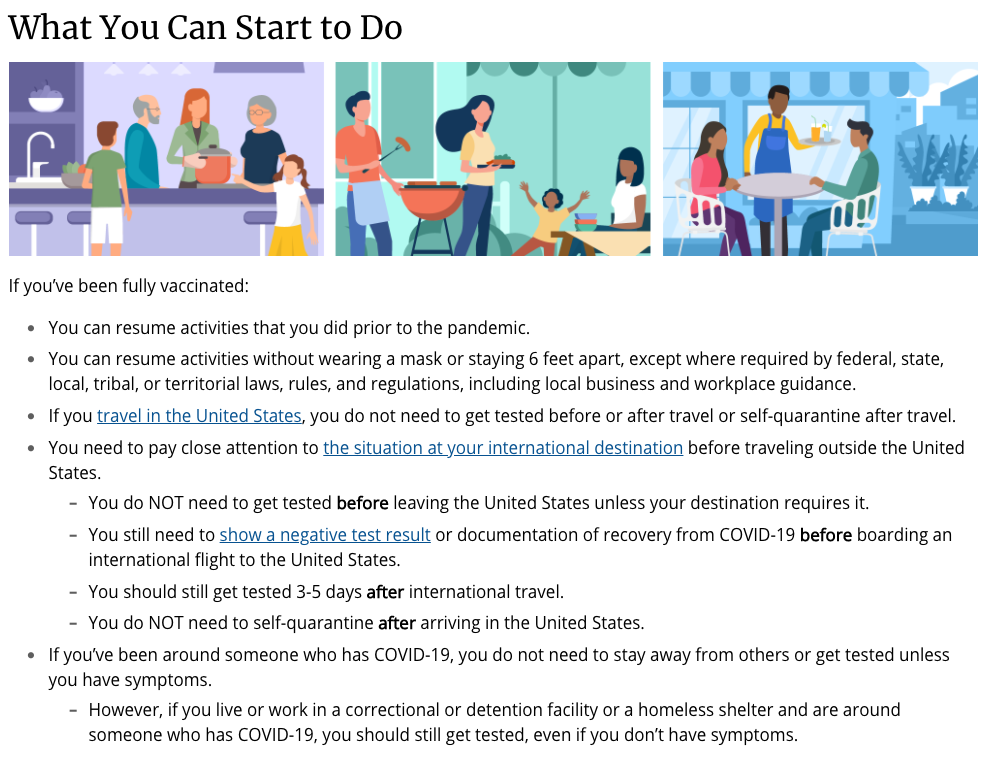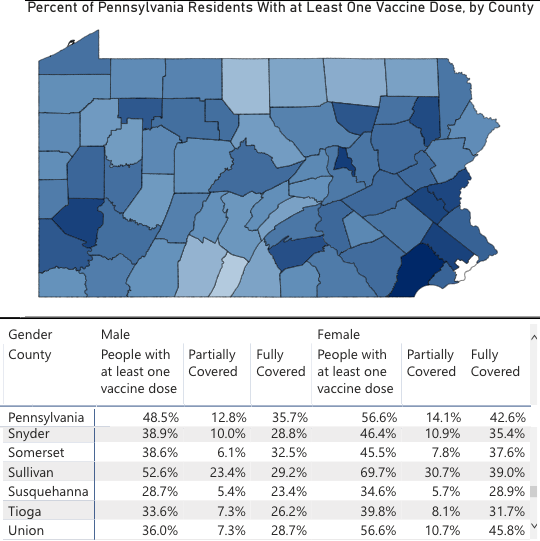We have long been encouraging everyone to wear masks -- well-fitted, high-filtration, properly positioned, in key scenarios -- as well as promoting vaccination as soon as that was an option. When the CDC announced recently that many restrictions on fully vaccinated people could be lifted, confusion arose about what that meant for masking in general.

Who does this apply to? Where does it apply?
To hear people talking initially, you would think the announcement meant we could all burn all our masks. Not quite! First off, the mask requirement relaxation only applies to fully vaccinated people. Second, it does not supersede other jurisdictions’ requirements – so PA state mask requirements stand, calling for masking indoors in public accommodations and outdoors in crowds. And thirdly, there are exceptions, even for the fully vaccinated -- masks should still be worn by everyone on transit, in healthcare settings, and in congregate living.
In addition to these exceptions, anyone who is vaccinated should also consider whether they share a household with someone at higher risk, for example anyone not yet fully vaccinated (many who only became eligible in mid-April), those unable to be vaccinated (children under 12 or people with certain medical conditions), or people with weakened immune systems (the very elderly or those undergoing chemotherapy, even if vaccinated). A vaccinated person who has long-term close contact with people in these categories may want to be cautious about going maskless around others.

Is the CDC announcement vindication for people who have rejected masks all along? Like a big I-told-you-so?
Well, no, it’s actually vindication for vaccines. They make this possible. Nor is it a rejection of masks as a way to reduce infections. Masks have been and continue to be very useful for that – for anyone who is not fully vaccinated or for those wanting to avoid other infections or even allergens. If you see someone wearing a mask now, there are many potential reasons for them to be doing so. They might just have a cold. The new recommendation is not even a rejection of mask mandates in general, but rather a prediction that we are making progress toward our goal of more immunity and less disease.
Is this an opportunity to point out hypocrisy? Are people who have long wanted everyone to follow the CDC suddenly deciding not to follow the CDC?
Not really. The fundamental point of the CDC announcement is that people who are fully vaccinated, absent other health issues, have broad protection and do not need to mask (or take many other precautions) on their own account. However, households and families may not all be in the same situation in their vaccination process or their overall level of health. So, given that broader situation, individuals who are themselves vaccinated may well be looking forward to the point when their household transitions into the fully vaccinated column.

So what are we protected from?
Those who are fully vaccinated appear to be both significantly protected from getting infected AND from transmitting it. However, the protection is not absolute. Some people may choose to accept that level of risk for unvaxxed others in their household. If they are vaccinated, that would seem to be within the realm of the reasonable and a personal choice. But especially if they have children too young to be vaccinated, they may want to consider not so much the risk of hospitalization and death but of other long term health impacts.
People like to talk about a "case-demic," thereby dismissing increasing case numbers if they are showing up only among the young. But local doctors are treating young patients who are dealing with a host of ongoing symptoms after they have otherwise recovered from the initial infection: shortness of breath, headache, function-limiting fatigue, and a post-concussion like syndrome/"brain fog."
Also, don't forget the variants! While the variants currently in circulation here seem to also be addressed adequately by the vaccines we have, there are new variants cropping up on a regular basis. Right now Brazil and India are struggling with outbreaks and "variants of concern." Even Japan and Vietnam, countries that have been very successful with non-pharmaceutical mitigation, i.e. masking and distancing, up to now, are facing abrupt growth in new cases that appear to be tied to compounded variants.
So how vaccinated/immune are we locally?
The CDC announcement didn’t note benchmarks that would allow us to calibrate our response to local vaccination levels, but we can look at the overall/national data to get a sense of where we stand. According to the CDC, the US (as of May 29) is 40.2% fully vaccinated and 50.1% partially vaccinated.
By contrast Pennsylvania is 43% full and 57.8% partial; Union County, 33.4% and 41.5%. So while the state is ahead of the country on both counts, the county is behind both the state and national averages. This means that in Union County the newly relaxed CDC mask recommendations apply to about a third of the residents -- even fewer than that 33% once you consider how many people in that category live with others who are not yet vaccinated.
Interestingly, the gender gap among those getting vaccinated is quite significant. For PA as a whole, currently 48.5% of men have at least one dose and 56.6% of women, for an overall gap of around 8%. But in Union County, 56.6% of women have had at least one dose but only 36% of men -- a 20 point deficit. What are men waiting for? Is it a misplaced sense of chivalry? In that case, we need them to step up and protect the community by getting rather than deferring the shot. Is it fear? Most adverse impacts show up within the first 6 weeks. Looking at the millions of people around the globe who have been fully vaccinated for more than 6 weeks now, the adverse impact of the vaccine is, as it should be, many orders of magnitude less than that of the disease.

And vaccination rates are just part of the stats to consider. How much has disease transmission slowed?
During the CDC announcement, the spokesperson noted that nationally cases, hospitalizations, and deaths are dropping. That’s great news, but it also conceals local variation. Those stats have been dropping for PA on average, too. But what about Union County? While there are far fewer people hospitalized and dying now than at the winter peak, the county curves dropped until about the middle of March, then rose slightly, and now are continuing along roughly level. Though they are not rising locally, they are not yet dropping decisively either. And those similar case numbers are cropping up among the unvaccinated, a subset of the whole population. (This one sentence encapsulates an entire new realm of number crunching which will be the focus of our next piece, along the lines of this article in the Washington Post about adjusting the rates based on the percentage of the population that is still vulnerable.)
It has taken us five months to get to where we are now with vaccinations. Allowing for the number of people already partially vaccinated who will shift into the fully vaccinated column in coming weeks, it looks like most counties in the state are approaching 40% fully vaccinated by May 31. If we make use of ample vaccine availability, the state could make it all the way to 70% by July 4. And the state, poring over the stats just like the rest of us is also coming to that conclusion, which helps make sense of the removal of mitigation (other than masking) at the end of May and the promise of the end of the mask mandate by the end of July, but also tying that to reaching 70%. Just remember that once we get to 70% as a state, all indications are that we will still be far from that level here.
So let's turn that possibility into a reality. It will only happen though if we pick up the current pace. So, let's do this!

At this point, it is quite easy to get an appointment or even find a walk-in site for COVID-19 vaccination. To find out where to get the shot, go to www.vaccines.gov, call 1-800-232-0233, text your zip code to GETVAX (438829) for English, or text your zip to VACUNA (822862) for Spanish.

